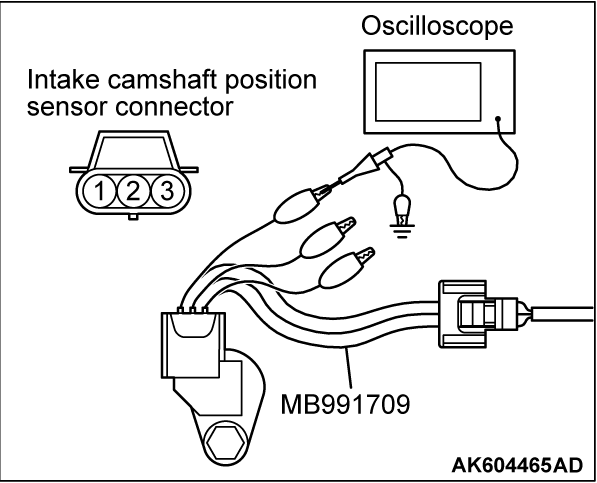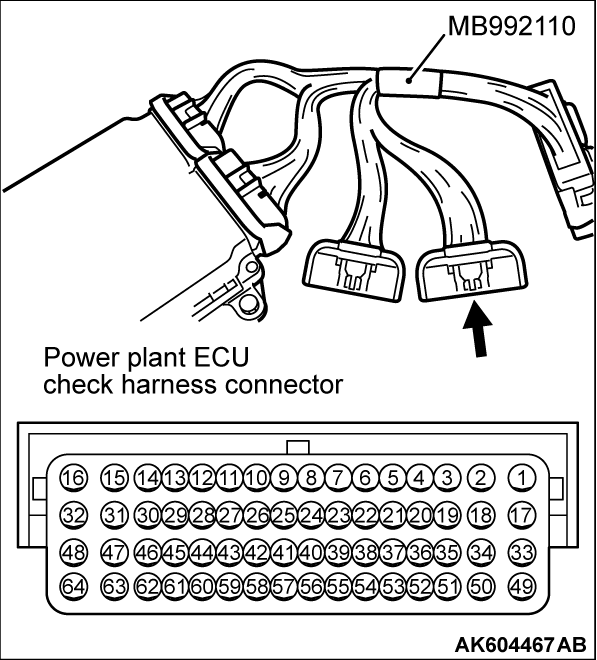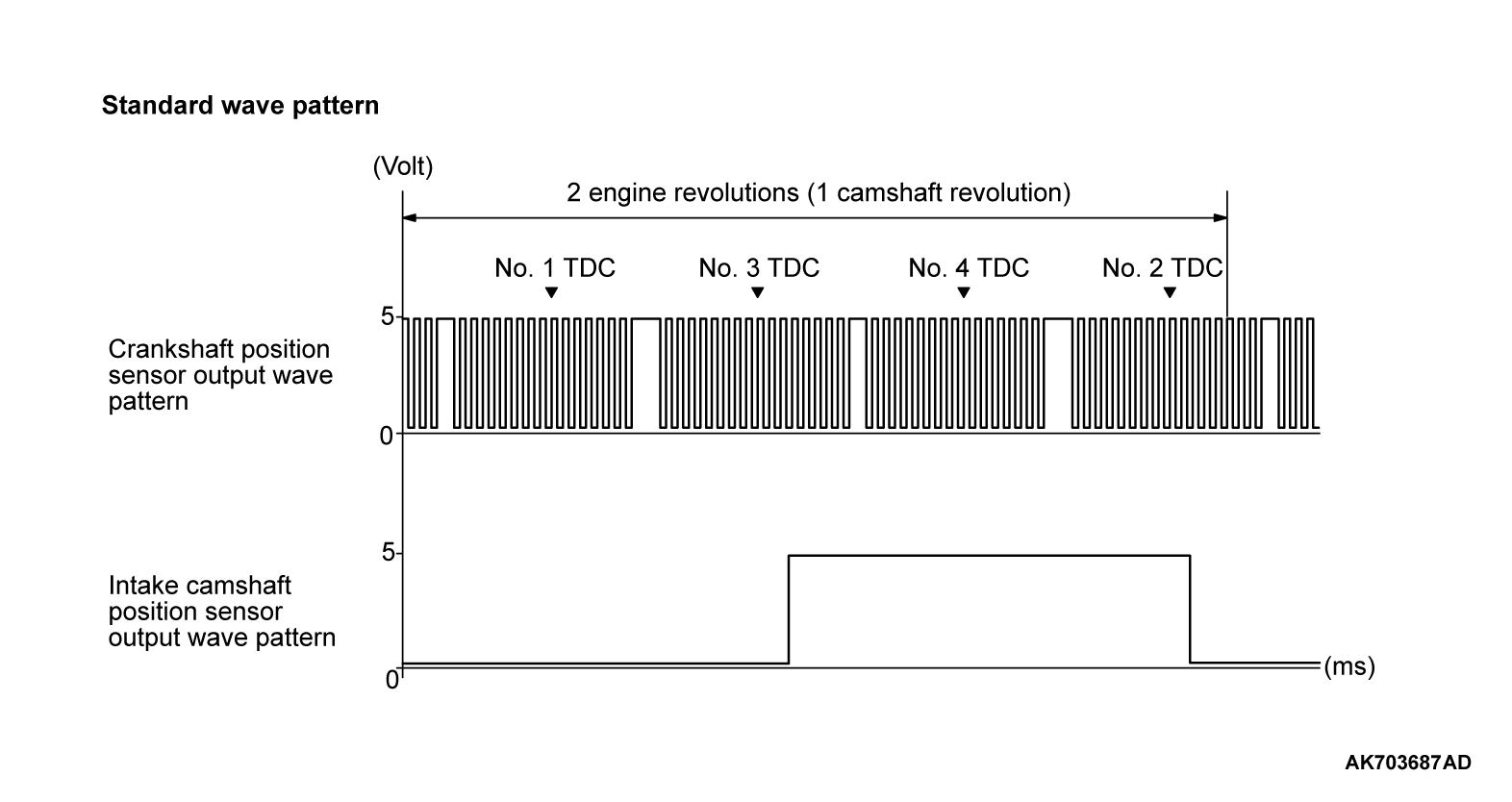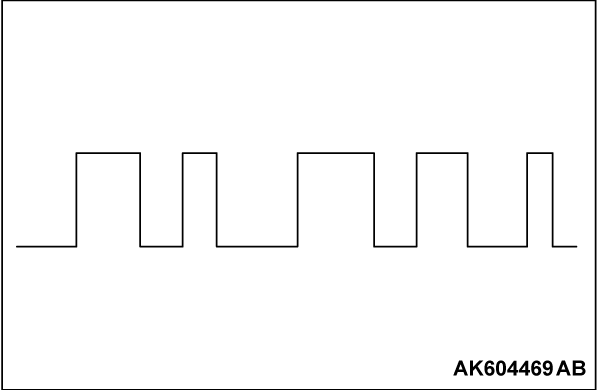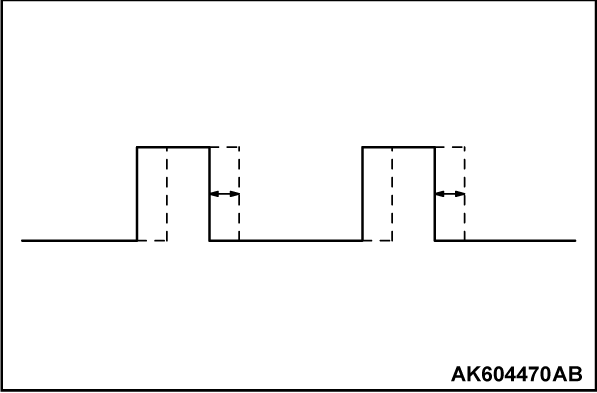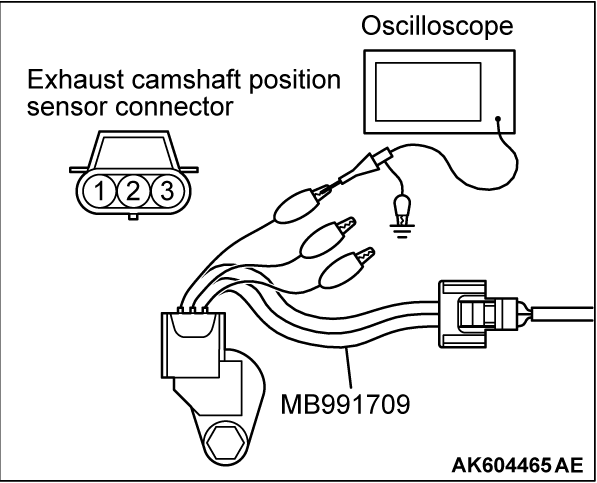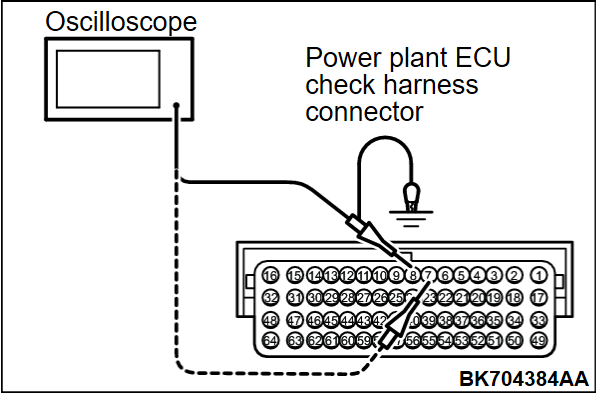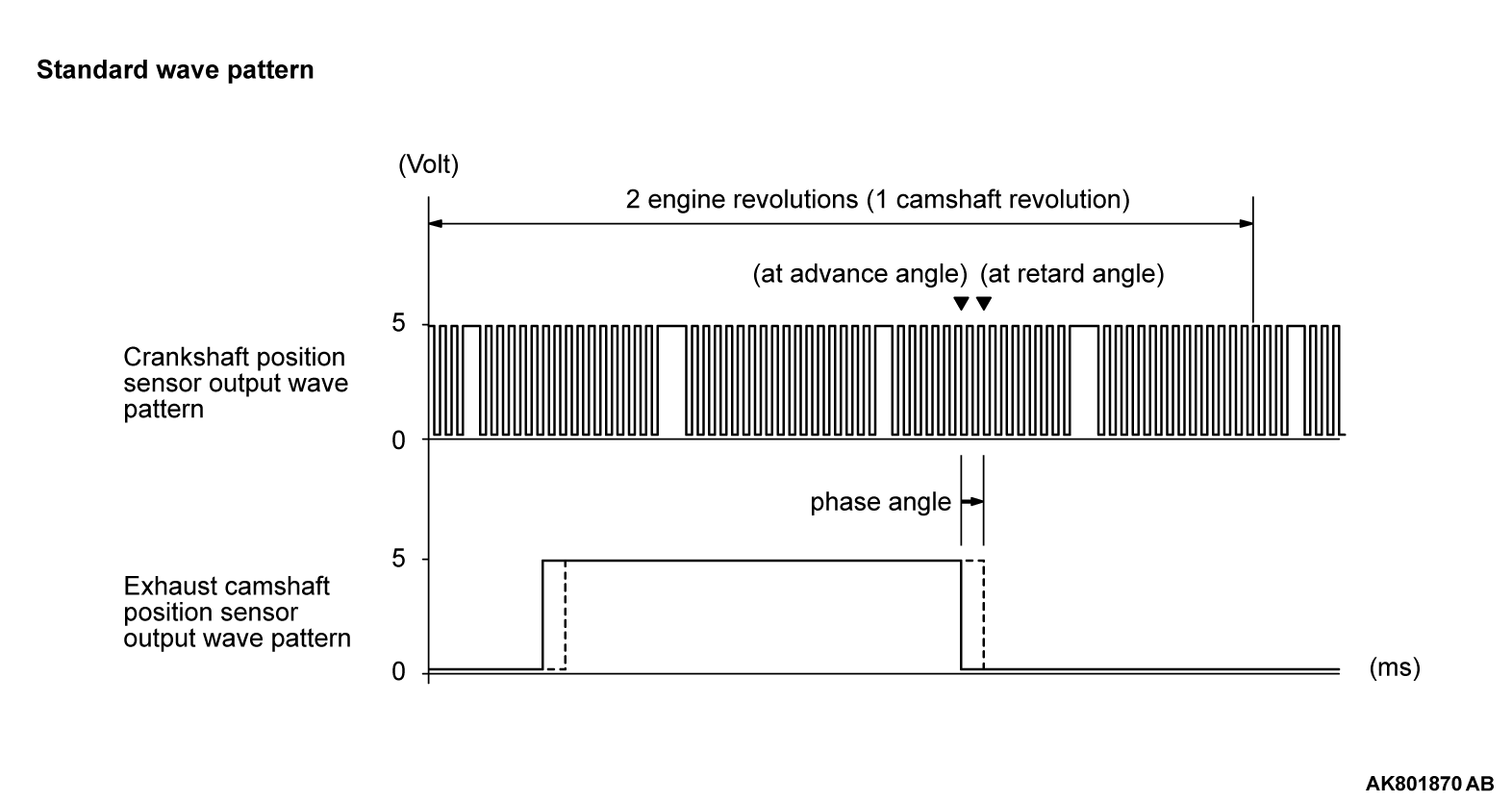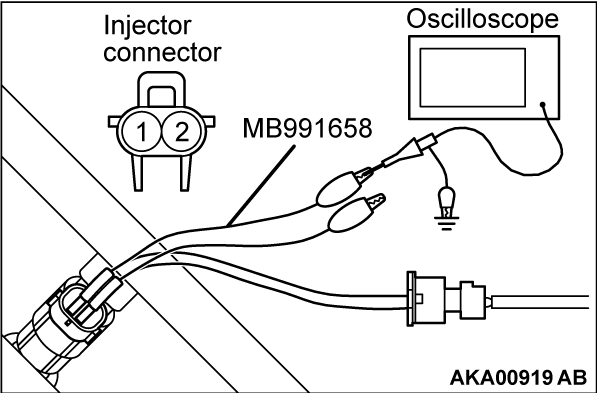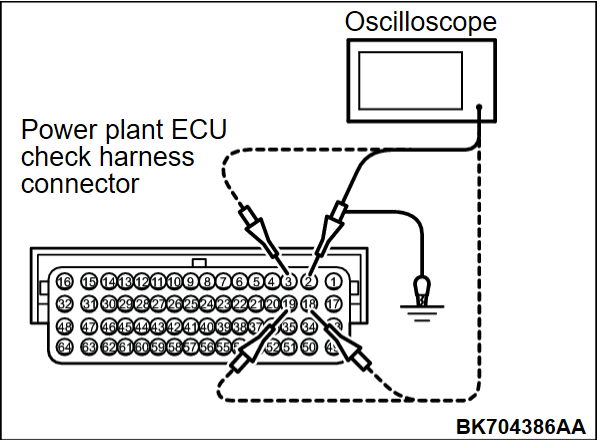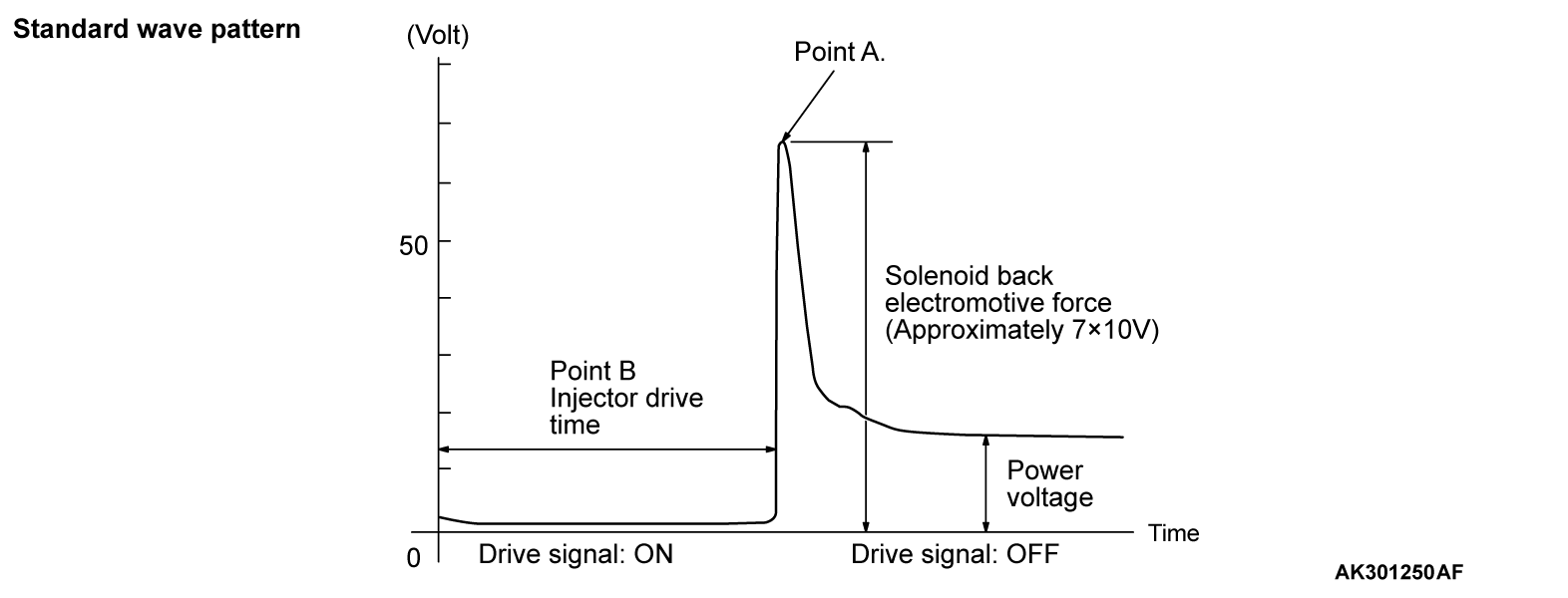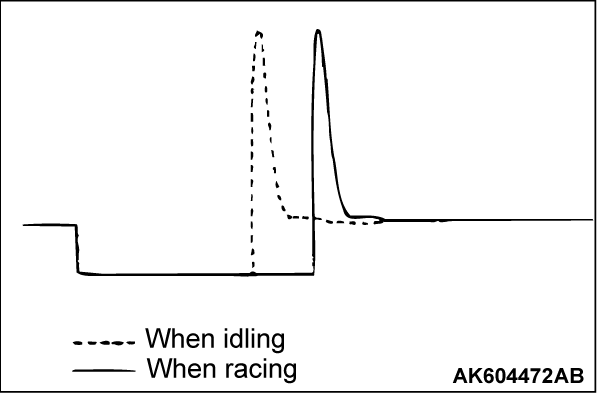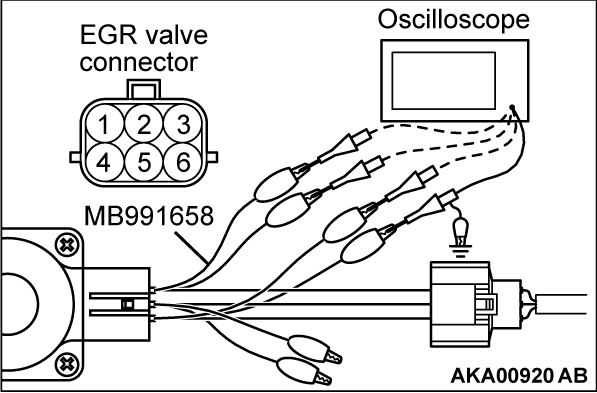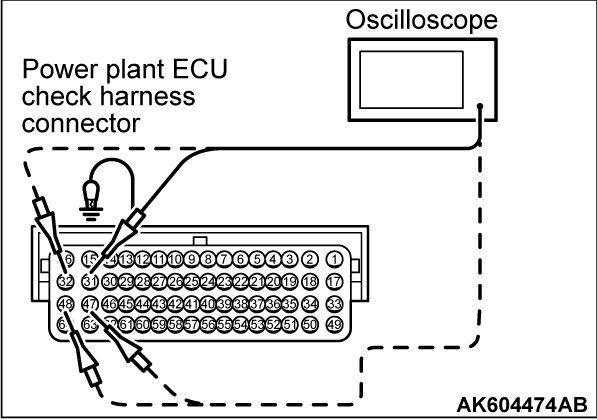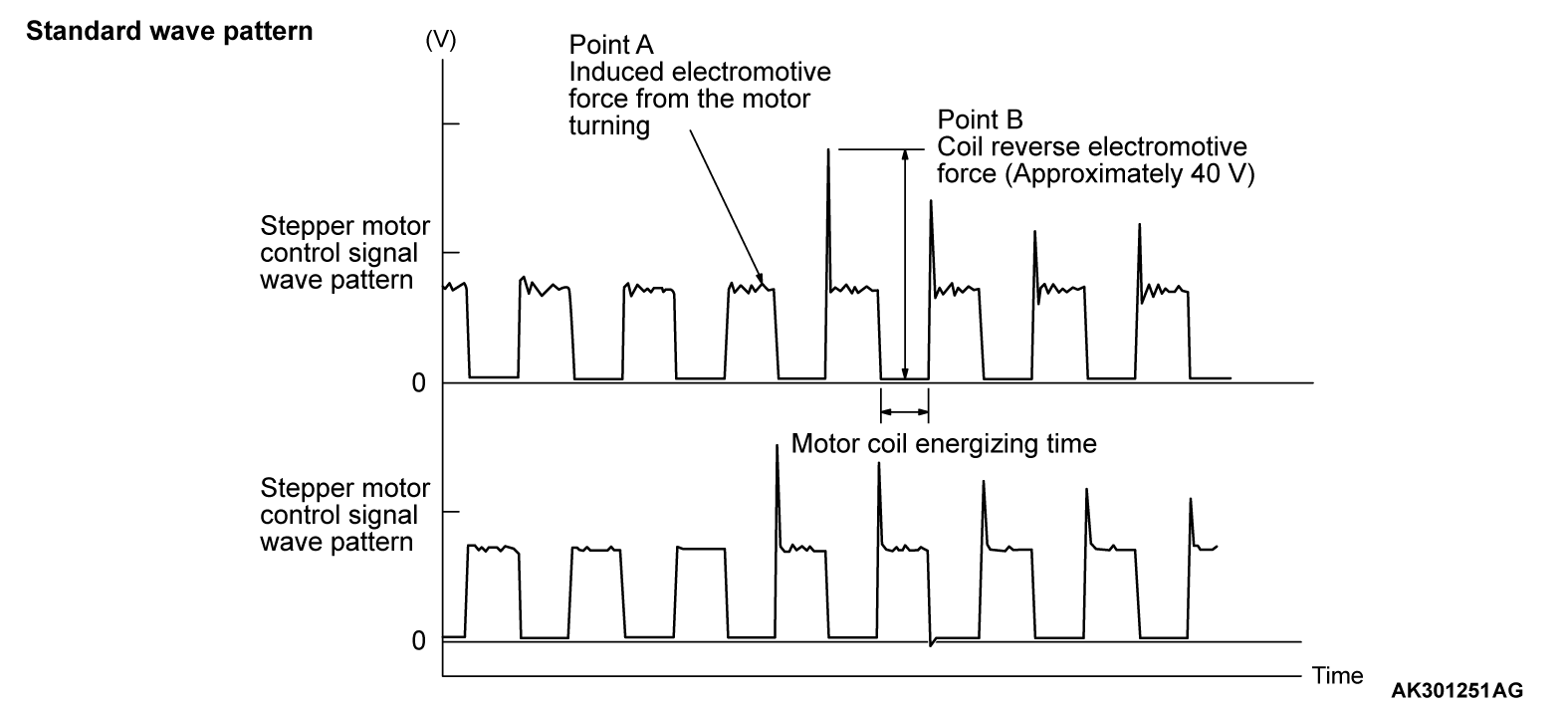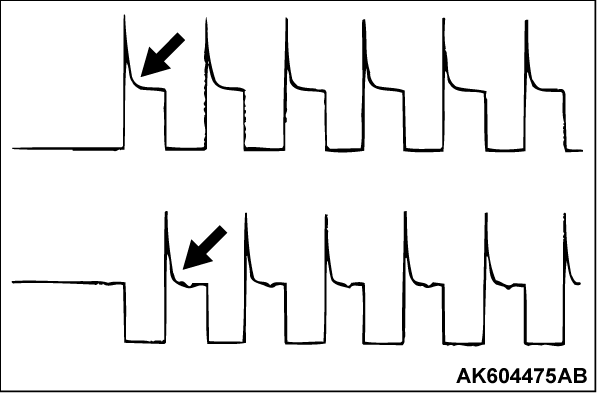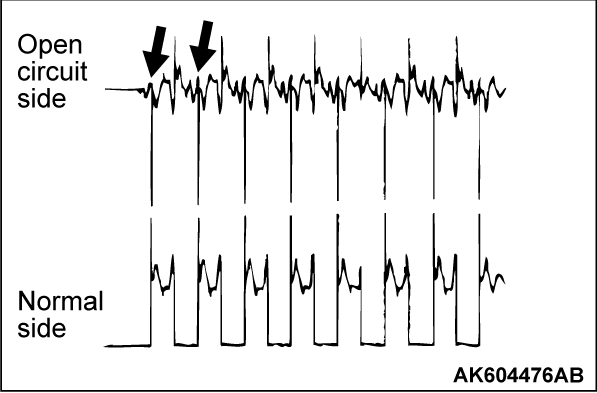INSPECTION PROCEDURE USING AN OSCILLOSCOPE
INTAKE CAMSHAFT POSITION SENSOR AND CRANKSHAFT POSITION SENSOR
Required Special Tools:
- MB991709: Test Harness
- MB992110: Power Plant ECU Check Harness
Measurement Method
1. Disconnect the intake camshaft position sensor connector, and connect the test harness special tool (MB991709) between the separated connector (All terminals should be connected).
2. Connect the oscilloscope probe to intake camshaft position sensor connector terminal No. 3.
3. Disconnect the crankshaft position sensor connector, and connect the test harness special tool (MB991709) between the separated connector (All terminals should be connected).
4. Connect the oscilloscope probe to crankshaft position sensor connector terminal No. 3.
Alternate method
1. Disconnect all ECM connectors. Connect the check harness special tool (MB992110) between the separated connectors.
2. Connect the oscilloscope to check harness terminal No. 14. (Check the intake camshaft position sensor signal wave pattern.)
3. Connect the oscilloscope to check harness terminal No. 8. (Check the crankshaft position sensor signal wave pattern.)
Standard Wave Pattern
| Observation condition | |
| Function | Special pattern |
| Pattern height | Low |
| Pattern selector | Display |
| Engine condition | Idle |
Wave Pattern Observation Points
- Verify that the sensor signal frequency increase as the engine speed rises.
Examples of Abnormal Wave Patterns
Example 1
- Cause of problem
- Sensor interface malfunction.
- Wave pattern characteristics
- Rectangular wave pattern is output even when the engine is not started.
Example 2
- Cause of problem
- Loose timing chain.
- Abnormality in sensor disc.
- Wave pattern characteristics
- Wave pattern is displaced to the left or right.
EXHAUST CAMSHAFT POSITION SENSOR AND CRANKSHAFT POSITION SENSOR
Required Special Tools:
- MB991709: Test Harness
- MB992110: Power Plant ECU Check Harness
Measurement Method
1. Disconnect the exhaust camshaft position sensor connector, and connect the test harness special tool (MB991709) between the separated connector (All terminals should be connected).
2. Connect the oscilloscope probe to exhaust camshaft position sensor connector terminal No. 3.
3. Disconnect the crankshaft position sensor connector, and connect the test harness special tool (MB991709) between the separated connector (All terminals should be connected).
4. Connect the oscilloscope probe to crankshaft position sensor connector terminal No. 3.
Alternate method
1. Disconnect all ECM connectors. Connect the check harness special tool (MB992110) between the separated connectors.
2. Connect the oscilloscope to check harness terminal No. 7. (Check the exhaust camshaft position sensor signal wave pattern.)
3. Connect the oscilloscope to check harness terminal No. 8. (Check the crankshaft position sensor signal wave pattern.)
Standard Wave Pattern
| Observation condition | |
| Function | Special pattern |
| Pattern height | Low |
| Pattern selector | Display |
| Engine condition | Idle |
Wave Pattern Observation Points
- Verify that the relative position of the exhaust camshaft position sensor's output wave changes when the low load operation changes to the high load operation.
Examples of Abnormal Wave Patterns
Example 1
- Cause of problem
- Sensor interface malfunction.
- Wave pattern characteristics
- Rectangular wave pattern is output even when the engine is not started.
Example 2
- Cause of problem
- Loose timing chain.
- Abnormality in sensor disc.
- Wave pattern characteristics
- Wave pattern is displaced to the left or right.
INJECTOR
Required Special Tools:
- MB991658: Test Harness
- MB992110: Power Plant ECU Check Harness
Measurement Method
- Disconnect the injector connector, and connect the test harness special tool (MB991658) between the separated connector. (All terminals should be connected.)
- Connect the oscilloscope probe to injector connector terminal No. 2.
Alternate method
- Disconnect all ECM connectors. Connect the check harness special tool (MB992110) between the separated connectors.
- Connect the oscilloscope probe to each check harness connector terminal to analyze each cylinder:
- Terminal No. 2 for the number 1 cylinder.
- Terminal No. 3 for the number 2 cylinder.
- Terminal No. 18 for the number 3 cylinder.
- Terminal No. 19 for the number 4 cylinder.
Standard Wave Pattern
| Observation conditions | |
| Function | Special pattern |
| Pattern height | Variable |
| Variable knob | Adjust while viewing the wave pattern |
| Pattern selector | Display |
| Engine condition | Idle |
Wave Pattern Observation Points
- Point A: Height of injector coil induced voltage.
| CONTRAST WITH STANDARD WAVE PATTERN | PROBABLE CAUSE |
| Injector coil induced voltage is low or doesn't appear at all | Short in the injector solenoid |
Point B: Injector drive time
- The injector drive time should be synchronized with the scan tool tester display.
- When the engine is suddenly revved, the drive time will be greatly extended at first, but the drive time will soon return to original length.
EGR VALVE (STEPPER MOTOR)
Required Special Tools:
- MB991658: Test Harness
- MB992110: Power Plant ECU Check Harness
Measurement Method
1. Disconnect the EGR valve connector, and connect the test harness special tool (MB991658) between the separated connector (All terminals should be connected).
2. Connect the oscilloscope probe to the EGR valve connector terminal No. 1, terminal No. 3, terminal No. 4, terminal No. 6 respectively.
Alternate method
1. Disconnect all ECM connectors. Connect the check harness special tool (MB992110) between the separated connectors.
2. Connect the oscilloscope probe to check harness terminal No. 31, No. 32, No. 47 and No. 48.
Standard Wave Pattern
| Observation condition | |
| Function | Special pattern |
| Pattern height | High |
| Pattern selector | Display |
| Engine condition | Revving |
Wave Pattern Observation Points
- Check that the standard wave pattern appears when the EGR valve is operating.
- Point A: Presence or absence of induced electromotive force from the motor turning. (Refer to abnormal wave pattern.)
| CONTRAST WITH STANDARD WAVE PATTERN | PROBABLE CAUSE |
| Induced electromotive force does not appear or is extremely small | Malfunction of motor |
- Point B: Height of coil back electromotive force
| CONTRAST WITH STANDARD WAVE PATTERN | PROBABLE CAUSE |
| Coil reverse electromotive force does not appear or is extremely small | Short in the coil |
Examples of Abnormal Wave Patterns
Example 1
- Cause of problem
- Malfunction of motor. (Motor is not operating.)
- Wave pattern characteristics
- Induced electromotive force from the motor turning does not appear.
Example 2
- Cause of problem
- Open circuit in the line between the EGR valve and the ECM.
- Wave pattern characteristics
- Current is not supplied to the motor coil on the open circuit side. (Voltage does not drop to 0 volt.) Furthermore, the induced electromotive force wave pattern at the normal side is slightly different from the normal wave pattern.
IGNITION COIL AND IGNITION POWER TRANSISTOR
Required Special Tools:
- MB991658: Test Harness
- MB992110: Power Plant ECU Check Harness
Measurement Method
- Disconnect the ignition coil connector, and connect test harness special tool (MB991658) between the separated connector. (All terminals should be connected.)
- Connect the oscilloscope probe to ignition coil connector terminal No. 2.
Alternate method
- Disconnect all ECM connectors. Connect the check harness special tool (MB992110) between the separated connectors.
- Connect the oscilloscope probe to each check harness connector terminal to analyze each cylinder:
- Terminal No. 4 for the number 1 cylinder.
- Terminal No. 5 for the number 2 cylinder.
- Terminal No. 20 for the number 3 cylinder.
- Terminal No. 21 for the number 4 cylinder.
Standard Wave Pattern
| Observation condition | |
| Function | Special pattern |
| Pattern height | Low |
| Pattern selector | Display |
| Engine condition | Idle |
Wave Pattern Observation Points
- Point: The power transistor control signal (ignition timing) is advanced when the engine speed is increased.
| CONDITION OF WAVE PATTERN BUILD-UP SECTION AND MAXIMUM VOLTAGE | PROBABLE CAUSE |
| Voltage value is too low | Open-circuit in ignition primary circuit |
![[Previous]](../../../buttons/fprev.png)
![[Next]](../../../buttons/fnext.png)
